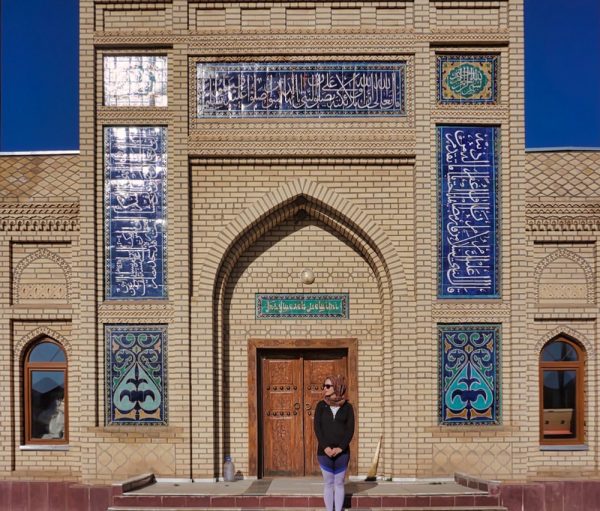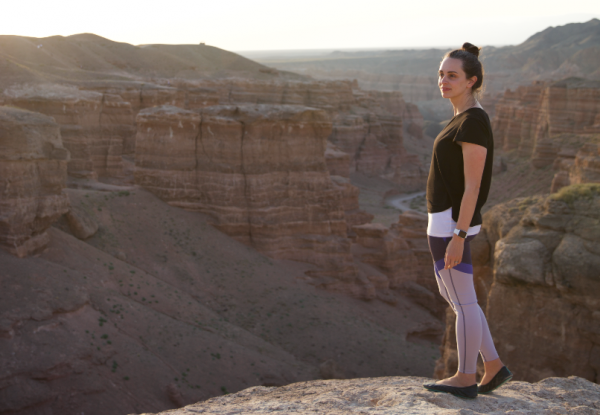If you’ve never heard of Central Asia – or your knowledge of the region is limited to scanning the map to identify “the Stans” and wonder if your travels will ever take you there – you’re not alone! Over the past few years, my own travels have become increasingly global, and I put a few of the countries in Central Asia on my ‘Someday’ list; especially picturesque Uzbekistan and Kazakhstan where you can watch a Russian rocket launch.
I had the chance to visit Central Asia earlier this year as part of a partnership with USAID. This is a U.S. government organization that helps promote tourism and commerce in different regions. As part of my partnership, I spent two weeks in Kazakhstan and Kyrgyzstan hiking insanely gorgeous trails, eating local meals, and staying in guest-houses of all shapes and sizes (including a yurt!)
Following my trip, I’m aware that as a woman, my experiences in Central Asia were different than my fellow male travelers. I decided to put together my thoughts to help you if you’re considering a trip to the region – and I asked other women travelers who joined me on this trip with USAID, who’ve scaled the highest peaks, and who’ve explored the cities and bazaars for their insights too. Together we’ve identified four main issues you might encounter as a woman traveling in Central Asia, and how to handle them in a culturally-conscious way.
Women’s Safety While Traveling in Central Asia
As you plan your trip to Central Asia, it’s important to remember that safety can vary widely from region to region across the globe – and from country to country. Nicole from Adventures of Lil Nicki has traveled widely in Central Asia and has some thoughts on women’s safety.
“Though Central Asia is still a very male-dominated region it’s still generally safe for female travelers, even solo and those traveling to more intrepid areas,” Nicole said. “Be prepared to be stared at – though this isn’t necessarily an aggression, usually just curiosity.”
Nicole does share that – like everywhere – there are bad actors who may make you feel unsafe, and she has some tips: “I’ve only ever had one man in all my Central Asia travels become aggressive with me and was easily fought away. In this case, some simple self-defense moves can prove helpful. Make a scene as it is generally not tolerated in most of Central Asia. Also, look for local women as they almost always will take you under their wing.”

In general, it also helps to keep some common-sense safety tips in mind, since you’re traveling in a foreign country and some issues (like how women dress and how men and women interact – both of which we’ve covered below) are more salient in Central Asia than other regions.
“Dress modestly with at least shoulders and knees covered, and keep a scarf handy in your bag for the impromptu pop-in to religious sites,” Nicole advises. “And since hitchhiking is quite common in Central Asia: When taking shared transport, try to pick a car/bus with women in it already.”
These tips will help you have a hassle-free trip even though the gender dynamics might be very different than those you know at home.
What to Pack and Wear as a Woman in Central Asia
Personally, my first question after learning about my trip to Central Asia was: “what do I pack?” As I’m sure many of us do, I wanted to dress respectfully for the different cultures I would encounter, but I also needed to balance that with adventure gear. Cynthia from Journal of Nomads has great tips to help you understand what to pack and wear as a woman traveling in Central Asia.
“There is no strict dress code for women,” she shared. “The local women don’t have to wear hijabs or headscarves so foreign women don’t have to cover their head either. However, with the exception of the capital cities, the local women dress rather conservatively.”

I found this to be true during my trip to Kazakhstan and Kyrgyzstan as well: in the cities, women wore every kind of outfit and style you can imagine while in the rural areas, women dressed more conservatively. This also varied based on the temperature and weather, of course. summer in Central Asia can be sweltering, but it’s better to choose breathable fabrics that cover you up instead of showing more skin.
“If you’re doubting what to wear during the summer and you don’t want to attract unwanted attention, just keep it simple: you’ll blend in if you wear a T-shirt and long cotton pants or a long skirt,” Cynthia concludes.
I spent most of my two weeks in Central Asia in yoga pants or long loose trousers and a tee-shirt, and felt like I was appropriately dressed throughout all of the adventures and cultural experiences I had.
Interactions with Men in Muslim Countries
“When traveling around Central Asia, there is so much you need to think about in terms of different customs to follow,” said Alesha from Nomadasaurus. “I have traveled through Kazakhstan, Kyrgyzstan, Tajikistan, Uzbekistan, and Turkmenistan many times and have learnt many of these differences.”
The majority of people living in Central Asia are Muslim, but how conservative they are – especially with regard to interactions between men and women, and with tourists or strangers, can vary widely depending on the setting. As a general rule, cities will be less conservative than more rural locations.

Alesha also shared some specific examples about traveling as a woman in Central Asia: “Men seeing other men will greet with a handshake. But unless females and males from different families are very close, they’ll often just speak without touching, or maybe shake hands,” she shared. “As a woman, some men won’t want to shake your hand as it’s seen as disrespectful to touch a woman who isn’t their partner or relative.”
That these types of cultural differences may not feel comfortable. Part of travel includes stepping outside your comfort zone and respecting what you find there – even when it doesn’t match up with your personal ideas of women’s status or how men and women interact.
Receiving Personal Questions from Locals in Central Asia
If you thought your mom, aunt, and grandma hassling you about when you’ll be getting married and/or have children was too much – be prepared that this is cranked up to 11 in Central Asia, even from complete strangers.
“Women traveling Central Asia are guaranteed to be asked one question more than any other: Are you married? Typically followed up by a question about children,” shares Alex from Lost with Purpose. “It’s a frustrating conversation to have. However, it’s important to remember that in many instances, someone asking if you’re married is a logical and common question for them.”
In Central Asia, especially in more conservative parts of the region, a woman’s marriage is akin to a man’s job. It’s the central part of her life, and her identity and social status can be wrapped up in her answers to “when do you want to get married?” and “why aren’t you married yet?” In fact, this isn’t that different from standards for women in some Western countries – it’s just a bit more common to be asked by people you don’t know well while in Central Asia.

How can you respond when someone asks you a personal question like this? Alex has a great answer: “There are a few ways you can respond to the question. Many female travelers just pretend they’re married. Personally, I prefer saying I’m single and I don’t want to get married. People always ask why, and I’ve found a simple answer usually puts them off and makes them laugh: Minye nravitsya svoboda (“I like freedom”) in Russian.”
Seems like a good phrase to keep in your back pocket while traveling anywhere!
Central Asia might feel light-years different from the areas you’re used to traveling – and these issues are obviously unique to each country and interaction you have while traveling there. That said, Central Asia is full of people who (like most hosts) are delighted to share their customs and culture with open-minded and inquisitive travelers. Whether you decide to try city-hopping through Almaty, Bishkek, and Samarkand, or head off the grid to hike the Pamir Highway in Tajikistan – now you have a better sense of traveling as a woman from women who’ve been there and paved the way.
This post was made possible by the support of the American People through the United States Agency for International Development (USAID) Competitiveness, Trade, and Jobs Activity in Central Asia. The contents of this publication do not necessarily reflect the views of USAID or the United States Government.














































